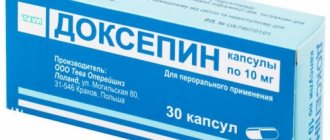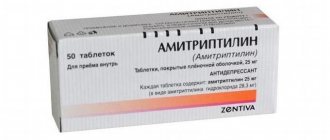The drug "Velafax" is part of a large group of antidepressants, but it occupies a special place in it. The drug can be used on an outpatient basis or in a hospital setting. With its help, you can fight various forms of depression, regardless of the severity of the condition. The Velafax medication comes with detailed instructions for use, but it is recommended to coordinate any actions related to the composition with your doctor. Each case of depression is unique, so the approach to taking an antidepressant must be individualized.
With Velafax you can fight various forms of depression, regardless of the severity of the condition.
Pharmacological profile
In terms of chemical parameters, Velafax is unique and represents a separate class of antidepressants.
Its mechanism of operation is associated with the ability of the main component to potentiate the transmission of nerve impulses to the central nervous system.
This substance and its active metabolite reduce the hyperreactivity of the nervous system and prevent the reuptake of norepinephrine and serotonin. The product does not affect opioid, benzodiazepine, histamine and other receptors, acting clearly and purposefully.
In terms of chemical parameters, Velafax is unique and represents a separate class of antidepressants.
After taking the antidepressant Velafax, it is rapidly and actively absorbed in the digestive tract. After 2.5 hours, the maximum concentration of the main substance is recorded in the blood plasma, and after another couple of hours - the active metabolite. If you take the tablet right before or immediately after a meal, the absorption time will increase by half an hour. The concentration indicators of the components will not change. The medication is processed by the liver, its components are excreted by the kidneys. The half-life of venlafaxine is 5 hours, and its metabolite is 11 hours.
Scope of application and contraindications
Velafax tablets are used to treat various forms of depression with and without agitation. They provide a therapeutic effect for large episodes and recurrent course of the disease.
In some cases, the product can be used for preventive purposes.
Doctors often introduce medicine as part of combined approaches for severe migraines, neuroses, and diabetic polyneuropathy.
Absolute contraindications to the use of the drug are allergies to its components, severe liver and/or kidney damage, and the patient’s age under 18 years. Therapy cannot be combined with taking MAO inhibitors. During pregnancy planning, childbearing and lactation, the product is replaced with safe analogues.
Taking the antidepressant Velafax for tachycardia, angina pectoris, hypertension, and increased intraocular pressure should be done with extreme caution. There are high risks of negative consequences if there is a history of seizures, lack of body weight, a tendency to bleed, or acute-angle glaucoma. It is not recommended to take the medication in the first six months after a myocardial infarction, with diagnosed mania or its less severe manifestations.
During pregnancy and breastfeeding
The safety of venlafaxine during pregnancy has not been proven, so use during pregnancy (or intended pregnancy) is only possible if the potential benefit to the mother outweighs the possible risk to the fetus. Women of childbearing age should be warned about this before starting treatment and should immediately consult a doctor if they become pregnant or plan to become pregnant during treatment with the drug.
Venlafaxine and its metabolite EDV are excreted in breast milk. The safety of these substances for newborns has not been proven, so taking venlafaxine during breastfeeding is not recommended. If it is necessary to take the drug during lactation, the issue of stopping breastfeeding should be decided. If maternal treatment was completed shortly before delivery, the newborn may experience drug withdrawal symptoms.
Contraindicated during pregnancy and lactation.
Dosage and treatment regimen
Velafax tablets are taken orally, without chewing, with liquid. Doctors recommend doing this every day at the same time, combining the procedure with meals. There are two standard treatment regimens, but in practice they can be adjusted by the doctor in accordance with the specifics of the situation.
Velafax tablets are taken orally, without chewing, with liquid.
Medication regimens depending on the severity of the situation:
- outpatient treatment of depression - first, the patient is prescribed 37.5 mg of the active substance twice a day. The patient requires observation for several weeks. If this approach does not produce any positive changes in the condition, the dosage is doubled, bringing it to 75 mg of the drug twice a day;
- inpatient therapy for severe disorder - treatment begins immediately with 75 mg of the active ingredient twice a day. Every 3 days the volume of the medicine is increased by 75 mg until the desired effect is achieved. In this case, the daily amount of medication should not exceed 375 mg of venlafaxine. When the desired response of the body is achieved, the daily volume begins to be slowly reduced to the minimum therapeutic value.
In order to prevent relapses, maintenance therapy is recommended for another six months after achieving the desired effect. In this case, the minimum effective dose for a particular patient is used. Discontinuation of the medication is carried out under medical supervision for at least 2 weeks.
Discontinuation of the medication is carried out under medical supervision for at least 2 weeks.
Release form, composition and packaging
The tablets are light yellow in color, oblong, with a score line on both sides.
| 1 tab. | |
| venlafaxine (hydrochloride) | 37.5 mg |
Excipients: microcrystalline cellulose, corn starch, yellow iron oxide (E172), sodium carboxymethyl starch (type A), talc, colloidal anhydrous silicon dioxide, magnesium stearate.
14 pcs. - blisters (2) - cardboard packs. 14 pcs. - blisters (4) - cardboard packs.
The tablets are light yellow, round, with a score line on one side and “PLIVA” engraved on the other.
| 1 tab. | |
| venlafaxine (hydrochloride) | 75 mg |
Excipients: microcrystalline cellulose, corn starch, yellow iron oxide (E172), sodium carboxymethyl starch (type A), talc, colloidal anhydrous silicon dioxide, magnesium stearate.
14 pcs. - blisters (2) - cardboard packs. 14 pcs. - blisters (4) - cardboard packs.
Cases of overdose
Exceeding the therapeutic volume of Velafax or consuming it simultaneously with alcoholic beverages can cause an overdose. The condition is characterized by increased or slow heart rate, a drop in blood pressure, and dizziness. There is a pathological change in the graph on the ECG. In severe cases, the patient experiences severe drowsiness, which can progress to a coma, and disturbances of consciousness are noted. If the patient is not helped in time, he may develop convulsions and there is a high probability of death.
Treatment should be carried out by professionals in a hospital setting. It is strictly forbidden to try to induce vomiting in the victim yourself; he may suffocate due to vomit entering the respiratory tract. Therapy is symptomatic, under the control of vital signs. If necessary, begin artificial ventilation. There are no antidotes for the drug; hemodialysis has no effect.
Side effects
Experts note the dependence of the frequency and severity of adverse reactions on the dosage of the drug and the duration of its use.
With prolonged therapy, the likelihood of a negative response from the body is minimal. The effects that appear at the start of the course are usually not significant, go away on their own and do not require cessation of treatment. In rare cases, a dose adjustment is required, after which the alarming symptoms disappear.
Possible side effects of taking the antidepressant Velafax:
- dyspeptic – nausea and vomiting, loss of appetite, abdominal discomfort, problems with stool. Very rarely, lesions of the pancreas or liver are detected;
- metabolic - gain or loss of body weight, increase in bad cholesterol or sodium deficiency in the blood;
- neurological - dizziness, nightmares, muscle weakness, daytime sleepiness, problems sleeping at night. Tremors, muscle spasms, apathy, and decreased sensitivity occur less frequently. Some patients experience hallucinations, fainting, balance problems, and seizures;
- mental – worsening depression, emergence of suicidal thoughts;
- dermatological – dry skin, hair loss, sweating;
- respiratory – sometimes shortness of breath occurs;
- immune - allergic reactions in the form of skin rash and itching. Sometimes patients have increased sensitivity to ultraviolet radiation. Severe conditions occur very rarely - anaphylactic shock, angioedema;
- from the heart and blood vessels - increased blood pressure and redness of the skin. Less commonly, a drop in blood pressure, increased heart rate, arrhythmia;
- from the senses - problems with visual perception, decreased quality of hearing. In rare cases, perversion of taste;
- from the genitourinary system - various problems with urination, decreased libido, problems with erection in men. Cycle disturbances and unrelated bleeding in women;
- hematopoiesis, lymphatic system - hemorrhages in the mucous membranes and skin, decreased platelet count, increased bleeding time;
- others – pain in muscles and/or joints, spasm of muscle fibers are rarely recorded.
The drug may cause an increase in bad cholesterol.
If you abruptly stop taking Velafax or reduce the dose, a kind of withdrawal syndrome may develop. It manifests itself in the form of drowsiness, muscle weakness, increased fatigue, headache, and nausea. In severe cases, the picture is complemented by confusion, mood swings, disorientation, convulsions, and impaired perception of the surrounding world.
Instructions for use VELAFAX
1. Suicide/suicidal ideation or clinical deterioration
All patients need to determine the risk of suicide and monitor possible deterioration of the clinical condition.
Depression increases the risk of suicidal thoughts and suicide attempts. This risk persists until stable remission occurs. Therefore, patients should be under constant medical supervision and should be given only small quantities of the drug capsules to reduce the risk of possible abuse and/or overdose.
Psychiatric disorders for which venlafaxine is prescribed may also be associated with an increased risk of suicide. In addition, these disorders may be comorbid with major depressive illness. The precautions required when treating patients with major depressive disorder should be observed when treating patients with other mental disorders.
Patients with a history of suicidal events or those who have experienced severe suicidal ideation prior to treatment are known to be at greater risk for suicidal ideation or suicide attempts and should undergo therapy with closer monitoring. A meta-analysis of placebo-controlled clinical trials of antidepressants in adult patients with mental disorders showed an increased risk of suicidal behavior with antidepressants compared with placebo in patients younger than 25 years.
Drug therapy, especially at the beginning of treatment and after dosage changes, should be accompanied by careful monitoring of patients, especially high-risk patients. Patients (and medical personnel) should be warned to monitor for any clinical deterioration, suicidal behavior or thoughts, unusual changes in behavior, and seek immediate medical attention if such symptoms occur.
Use in children and adolescents under 18 years of age.
Venlafaxine should not be used to treat children and adolescents under 18 years of age. Suicidal behavior (suicide attempts and suicidal ideation) and hostility
(mainly aggression, disruptive behavior and anger) were observed more frequently in clinical trials among children and adolescents treated with antidepressants compared with placebo. If, based on clinical needs, a decision about therapy is made, the patient should be carefully assessed for the emergence of suicidal symptoms. In addition, long-term safety data in children and adolescents regarding growth, maturation, changes in consciousness, and behavioral responses are lacking.
2. Serotonin syndrome
As with other serotonergic agents, serotonin syndrome, a potentially life-threatening condition, can occur with venlafaxine therapy, especially with concomitant use of other agents such as MAO inhibitors, which can affect serotonergic neurotransmitters.
Symptoms of serotonin syndrome:
- mental status changes (eg, agitation, hallucinations, coma), autonomic nervous system disorders (eg, tachycardia, labile blood pressure, hyperthermia), neuromuscular aberrations (eg, hyperreflexia, incoordination), and/or gastrointestinal disorders (eg , nausea, vomiting, diarrhea).
3. Angle-closure glaucoma
Cases of mydriasis have been reported while taking venlafaxine, so patients with a predisposition to increased intraocular pressure or at risk of angle-closure glaucoma require careful medical monitoring.
4. Blood pressure
Dose-dependent increases in blood pressure have been reported with venlafaxine use. In some cases, in post-marketing studies, acute increases in blood pressure requiring immediate treatment have been reported. All patients with a history of hypertension should have their blood pressure checked before starting treatment. Blood pressure should be checked periodically after starting treatment and after increasing the dose. Caution should be exercised when treating patients in whom increased blood pressure may affect underlying medical conditions, such as patients with cardiac dysfunction.
5. Heart rate
Venlafaxine may cause an increase in heart rate, especially at high doses. Caution should be exercised when treating patients in whom an increase in heart rate may affect underlying medical conditions.
6. Heart disease and risk of arrhythmia
Venlafaxine has not been studied in patients who have recently had a myocardial infarction or other heart disease. Therefore, it should be used with caution in such patients. In post-marketing data, fatal cardiac arrhythmias have been reported with the use of venlafaxine, especially in overdose. Before prescribing venlafaxine to patients at high risk of serious cardiac arrhythmias, the benefits and risks of this therapy should be considered.
7. Cramps
Seizures may occur during venlafaxine therapy. Like all antidepressants, venlafaxine should be used with caution in patients who regularly experience seizures. Such patients should be closely monitored during therapy. Treatment should be discontinued in any patient who experiences seizures.
8. Hyponatremia
Hyponatremia and/or syndrome of insufficient antidiuretic hormone secretion (SIADH) may occur during venlafaxine therapy, especially in patients with dehydration or decreased blood volume. Elderly patients, patients taking diuretics, and patients with reduced blood volume are at greater risk with therapy.
9 Abnormal bleeding
Medicines that interfere with the absorption of serotonin may cause decreased platelet function. The risk of bleeding from the skin and mucous membranes, including gastrointestinal bleeding, may increase while taking venlafaxine. Like other serotonin reuptake inhibitors, venlafaxine should be used with caution in the treatment of patients predisposed to bleeding, including patients on platelet inhibitors and anticoagulants.
10.Serum cholesterol
In a placebo-controlled clinical trial, there was a significant increase in serum cholesterol levels in 5.3% of patients treated with venlafaxine compared with 0% of patients treated with placebo for at least 3 months. During long-term therapy with venlafaxine, serum cholesterol levels should be measured regularly.
11. Simultaneous use with drugs for weight loss
The effectiveness and safety of treatment with venlafaxine in combination with weight loss drugs, including phentermine, have not been established. Concomitant use of venlafaxine and weight loss medications is not recommended. Venlafaxine is not indicated for the treatment of excess weight, either alone or in combination with other drugs.
12.Manic syndrome/hypomania
Manic syndrome/hypomania may occur in a small number of patients with mental disorders during treatment with antidepressants, including venlafaxine. As with other antidepressants, venlafaxine should be used with caution in patients with a history of bipolar disorder or a family history of bipolar disorder.
13.Aggression
When taking antidepressants, including venlafaxine, a small number of patients may experience aggression. It can be observed at the beginning of therapy, when changing the dosage of the drug and stopping treatment. Like other antidepressants, venlafaxine should be used with caution in patients who have had episodes of aggression.
14. Termination of treatment
Withdrawal syndromes after discontinuation of treatment are common, especially when therapy is abruptly stopped. In clinical trials, adverse events occurred at discontinuation of treatment (dose taper or thereafter) in approximately 35% of patients receiving venlafaxine and 17% of patients receiving placebo. The risk of withdrawal symptoms may depend on several factors, including duration of therapy, dosage, and rate of dosage reduction. Dizziness, sensory disturbances (including paresthesia), sleep disturbances (including insomnia and intense dreams), agitation or anxiety, nausea and/or vomiting, tremors and headaches are the most common side effects. Typically, all symptoms were mild to moderately severe, but in some patients they could be severe. They usually occur within the first few days after stopping treatment, but very rarely such symptoms have been reported in patients who accidentally missed one dose of the drug. Typically, these symptoms are self-limiting and resolve within 2 weeks, although in some people they may last longer (2-3 months or more). Therefore, we recommend that venlafaxine therapy be discontinued gradually over several weeks or months, depending on the patient's needs.
15. Akathisia/psychomotor agitation
The use of venlafaxine has been associated with the development of akathisia, which causes patients to experience unpleasant feelings of restlessness or anxiety, as well as a need to move regularly with an inability to sit or stand still. Most often, this occurs during the first few weeks of treatment. In patients who develop these symptoms, increasing the dosage may have harmful effects.
16. Dry mouth
Dry mouth was noted in 10% of patients taking venlafaxine. This may increase the risk of tooth decay. Patients should be reminded of the importance of oral hygiene.
Impact on the ability to drive vehicles and operate machinery
Although venlafaxine has not been shown to affect psychomotor function, thinking, or decision-making in healthy volunteers, any psychotropic drug may affect decision-making or psychomotor function. Therefore, patients should be warned not to drive a car or operate dangerous machinery.
Special patients and instructions
In some cases, using the drug according to the standard regimen can cause more harm to the patient than good.
In such situations, it is necessary to act taking into account the specifics of the medication and the characteristics of the patient’s condition.
Important points in using Velafax:
- with reduced kidney function, the basic dosage is reduced by 25-50% depending on the severity of the case. In this case, the entire daily dose is given to the patient at one time. Against the background of severe organ damage, it is better to refrain from using the medication;
- with moderately reduced liver functionality, the daily volume of the drug is reduced by 50%;
- adjustment of medication dosages for elderly people is required only in the presence of somatic diseases;
- The first few weeks of therapy should, if possible, be carried out in a hospital setting so that it is possible to assess the body’s response to Velafax. In the case of depression, medications can lead to suicidal thoughts;
- Individuals with controlled epilepsy are advised to undergo treatment under medical supervision. Uncontrolled seizures are a contraindication to the use of the composition;
- Elderly people under the influence of the drug may experience problems with coordination, so they should take special care;
- Velafax is not prescribed to patients with chronic alcohol dependence. Even therapeutic doses of medication can provoke an overdose when combined with alcohol;
- The effect of the drug on the fetus has not been established; it is prohibited to take it during pregnancy. The main substance of the composition and its active metabolite pass into breast milk, which is why therapy is not combined with lactation.
The effect of the drug on the fetus has not been established; it is prohibited to take it during pregnancy.
Velafax does not dull attention or suppress psychomotor reactions, but it is better to avoid driving vehicles during the course. These negative effects may occur as side effects, creating unnecessary risks.
Patients have their own opinions
About 3 years ago, many problems happened in my life that put me into a prolonged depression. First of all, it was my son’s illness, but thank God everything has returned to normal.
I was also betrayed by a loved one, and this was already a last resort. At that moment I simply didn’t want to live, it lasted almost 1.5 years, and that’s a lot. It turns out that in these cases you need to go to the doctor, I didn’t know until my sister told me.
After taking it, the doctor said that I needed to take the drug Venlafaxine for 6 months. After the full course of treatment, everything returned to normal, and there were no side effects.
Vera, 32 years old
About 2 years ago I began to notice that I was having frequent attacks of depression, anxiety, and panic. Every day these conditions only intensified more and more. As a result, I began to have difficulty sleeping, severe headaches, and irritability.
I immediately went to see a psychotherapist. He prescribed me to take the drug Venlafaxine. I took it for about 6 months, all the unpleasant symptoms went away, my condition returned to normal. True, during the first time of treatment there were many side effects.
Sofia, 29 years old
Interaction with other drugs
The simultaneous use of medication and alcohol significantly increases the effect of the latter on the central nervous system. Such combinations threaten overdose, drug poisoning, and acute alcohol intoxication. The medicine cannot be used in conjunction with MAO inhibitors. An antidepressant is prescribed no earlier than 2 weeks after stopping the inhibitors. With the reverse approach, it is enough to wait a week.
Combining the composition with antipsychotics is prohibited. Violation of the rule threatens the appearance of symptoms characteristic of neuroleptic malignant syndrome. Combination with Clozapine can cause severe side effects. Cimetidine slightly enhances the medicinal properties of the product. Velafax enhances the anticoagulant properties of Warfarin.
Combination with Clozapine can cause severe side effects.
Synonyms of nosological groups
| Category ICD-10 | Synonyms of diseases according to ICD-10 |
| F32 Depressive episode | Adynamic subdepression |
| Astheno-adynamic subdepressive states | |
| Astheno-depressive disorder | |
| Astheno-depressive state | |
| Asthenodepressive disorder | |
| Asthenodepressive state | |
| Major depressive disorder | |
| Sluggish depression with lethargy | |
| Double depression | |
| Depressive pseudodementia | |
| Depressive illness | |
| Depressive mood disorder | |
| Depressive disorder | |
| Depressive mood disorder | |
| Depressive state | |
| Depressive disorders | |
| Depressive syndrome | |
| Depressive syndrome larvated | |
| Depressive syndrome in psychosis | |
| Masked depressions | |
| Depression | |
| Depression of exhaustion | |
| Depression with symptoms of lethargy within the framework of cyclothymia | |
| Depression smiling | |
| Involutional depression | |
| Involutionary melancholy | |
| Involutional depressions | |
| Manic-depressive disorder | |
| Masked depression | |
| Melancholic attack | |
| Neurotic depression | |
| Neurotic depression | |
| Shallow depressions | |
| Organic depression | |
| Organic depressive syndrome | |
| Simple depression | |
| Simple melancholic syndrome | |
| Psychogenic depression | |
| Reactive depression | |
| Reactive depression with moderate psychopathological symptoms | |
| Reactive depressive states | |
| Reactive depression | |
| Recurrent depression | |
| Seasonal depressive syndrome | |
| Senestopathic depression | |
| Senile depression | |
| Senile depression | |
| Symptomatic depression | |
| Somatogenic depression | |
| Cyclothymic depression | |
| Exogenous depression | |
| Endogenous depression | |
| Endogenous depressive states | |
| Endogenous depression | |
| Endogenous depressive syndrome | |
| F33 Recurrent depressive disorder | Major depressive disorder |
| Secondary depression | |
| Double depression | |
| Depressive pseudodementia | |
| Depressive mood disorder | |
| Depressive disorder | |
| Depressive mood disorder | |
| Depressive state | |
| Depressive syndrome | |
| Masked depressions | |
| Depression | |
| Depression smiling | |
| Involutional depression | |
| Involutional depressions | |
| Masked depression | |
| Melancholic attack | |
| Reactive depression | |
| Reactive depression with moderate psychopathological symptoms | |
| Reactive depressive states | |
| Exogenous depression | |
| Endogenous depression | |
| Endogenous depressive states | |
| Endogenous depression | |
| Endogenous depressive syndrome | |
| F41.2 Mixed anxiety and depressive disorder | Depression with anxiety-depressive components |
| Mixed anxiety and depression | |
| Anxious depression | |
| Anxious-depressive mood | |
| Anxiety and depression | |
| Anxiety and depression | |
| Anxiety-depressive syndrome | |
| Anxiety-neurotic conditions |
Velafax is stored at a temperature not exceeding 30 °C, out of the reach of children. Shelf life – 24 months.
Store in a dry, cool place, out of direct sunlight, at a temperature not exceeding 25 °C. Keep away from children. Shelf life – 3 years.
Doctors' opinions and patient advice
Neurologists, psychotherapists and psychiatrists highly appreciate the characteristics of the drug, recognizing its effectiveness. Experts actively prescribe it to patients with various forms of depression, migraines, and neuroses. According to doctors, following the rules of therapy allows you to achieve the desired result without risks to the patient’s health.
Consumers themselves also recognize a significant increase in quality of life after taking medication courses. Patients note good tolerability of the drug, ease of use, and the absence of negative consequences of therapy. In rare cases, side effects are observed, but they are usually mild and quickly go away on their own or after adjusting the dosage. Negative reviews are mainly due to violation of the rules for taking pills. In particular, those who abruptly stopped treatment noted the appearance of suicidal thoughts and a general deterioration in their health.
Doctor Review
Venlafaxine is an antidepressant that helps eliminate depressive disorders and concomitant mental disorders of the central nervous system.
I often prescribe this medication to my patients for disorders of the nervous system, feelings of anxiety, panic fears, and during severe depressive states.
At first, the effect of taking the drug is not observed, this is due to its slow action. After 1 year of use, the condition is completely normalized, the nervous system is restored. True, side effects may appear in the first few weeks of treatment, but they quickly pass.
Psychiatrist









